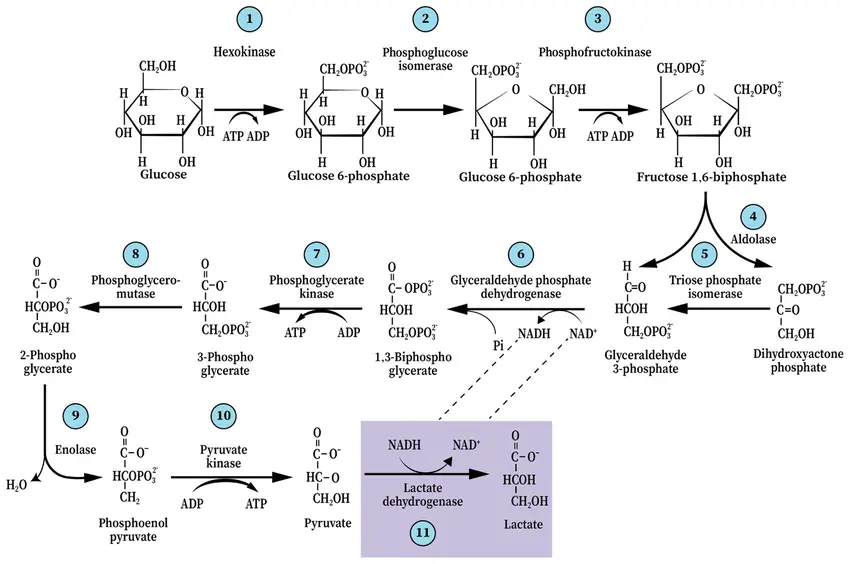Glycolysis
The Central Energy Factory of the Cell
Glycolysis is one of the most fundamental metabolic pathways found in almost every organism on Earth—from bacteria to humans. It is the first stage in the breakdown of glucose to extract energy for cellular metabolism. Occurring in the cytoplasm, glycolysis transforms one molecule of glucose (a six-carbon sugar) into two molecules of pyruvate (a three-carbon compound), producing small amounts of energy in the form of ATP and NADH.
🧪 What Is Glycolysis?
Glycolysis literally means "sugar splitting." It is a ten-step enzymatic pathway that:
- Requires no oxygen (anaerobic process)
- Occurs in all cell types
- Plays a central role in both aerobic and anaerobic respiration
🧬 Key Functions of Glycolysis
✔ Provides quick energy (ATP)
✔ Supplies intermediates for other metabolic pathways
✔ Generates pyruvate for the citric acid cycle or fermentation
✔ Occurs even when oxygen is absent, ensuring energy availability
🔁 Steps of Glycolysis
🔹 Phase 1: Energy Investment Phase (Steps 1–5)
Uses 2 ATP molecules to prepare glucose for splitting.
- Hexokinase phosphorylates glucose to glucose-6-phosphate (G6P)
- Phosphoglucose isomerase converts G6P into fructose-6-phosphate (F6P)
- Phosphofructokinase-1 (PFK-1) adds another phosphate, forming F1,6BP
- Aldolase splits F1,6BP into two 3-carbon sugars: DHAP and GAP
- Triose phosphate isomerase interconverts DHAP ↔ GAP
🔹 Phase 2: Energy Payoff Phase (Steps 6–10)
Produces 4 ATP and 2 NADH per glucose (net gain = 2 ATP).
- Glyceraldehyde-3-phosphate dehydrogenase forms 1,3-BPG and NADH
- Phosphoglycerate kinase generates 2 ATP (substrate-level phosphorylation)
- Phosphoglycerate mutase shifts the phosphate group
- Enolase forms phosphoenolpyruvate (PEP)
- Pyruvate kinase transfers phosphate from PEP to ADP → 2 ATP + 2 pyruvate
🌬 What Happens After Glycolysis?
- In the presence of oxygen: Pyruvate enters the mitochondria and is further oxidized in the citric acid cycle (Krebs cycle) followed by oxidative phosphorylation, yielding ~36 ATP.
- In absence of oxygen: Pyruvate undergoes fermentation, becoming lactate (in humans), regenerating NAD⁺ to keep glycolysis running.
🧰 Enzymatic Regulation of Glycolysis
The pathway is tightly regulated to meet energy demands and metabolic needs. Key control enzymes:
- Hexokinase: inhibited by G6P (feedback inhibition)
- Phosphofructokinase-1 (PFK-1): major control point; activated by AMP, inhibited by ATP and citrate
- Pyruvate kinase: activated by F1,6BP; inhibited by ATP and alanine
🧩 Glycolysis in Biotechnology and Medicine
| Field | Relevance of Glycolysis |
|---|---|
| Cancer Biology | Cancer cells rely heavily on glycolysis (Warburg effect) even in oxygen-rich environments |
| Medical Diagnostics | Lactate production via glycolysis is a marker for sepsis and tissue hypoxia |
| Biofuel Production | Microorganisms engineered to optimize glycolytic flux can produce ethanol and other biofuels |
| Synthetic Biology | Rewired glycolytic pathways enhance production of chemicals like succinate, lactate, and acetate |
| Sports Science | Understanding glycolysis helps optimize energy management and fatigue resistance in athletes |
🔭 Did You Know?
- Glycolysis predates oxygen-based life and is believed to be among the earliest metabolic pathways to evolve.
- In red blood cells, glycolysis is the only source of ATP because they lack mitochondria.
- Glycolysis is conserved across nearly all forms of life—a testament to its efficiency and evolutionary importance.
Glycolysis is not just the first step in breaking down glucose—it's a finely tuned, energy-generating engine at the heart of cellular metabolism. Its products fuel respiration, biosynthesis, and even influence cell signaling and disease states. Understanding this pathway unlocks insights across biology, biotechnology, and medicine.
